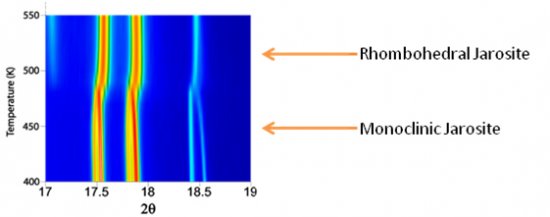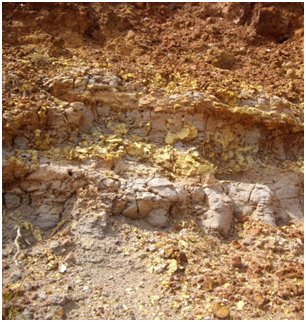Useful in some mineral processes but a major problem in others, jarosite may be the key to unlocking the geological history and environmental context of water on Mars.
Jarosite minerals are widespread in a number of industrial and environmental settings, and can act either as heroes or villains. For example, jarosite is deliberately produced to remove iron from hydrometallurgical circuits in zinc production facilities such as the plant on Tasmania’s Derwent River. However, it can also adversely affect the kinetics of metal bioleaching systems. Jarosites are also a major component of acidic soils, and present in significant amounts in acid mine drainage environments. Researchers are developing sustainable solutions to jarosite stockpiles created as by-products of mineral and industrial processes.
On Mars, Jarosite may represent the key to unlocking the geological history and environmental context of water on the red planet. Jarosites were the first hydrated minerals detected on Mars by the MER rover Opportunity, using Mössbauer spectroscopy.
 Image at left: The outcrop on Mars where jarosite was first detected. PIA05869 Credit: NASA
Image at left: The outcrop on Mars where jarosite was first detected. PIA05869 Credit: NASA
Understanding jarosite formation, mineralogy and stability is essential for streamlining industrial processes that involve jarosites, and understanding the geological evolution of the environments in which they abound.
For the last four years, a team from CSIRO Process Science and Engineering, ANSTO’s Bragg Institute and the Australian Synchrotron has been using a combination of in-situ and ex-situ characterisation techniques to investigate the formation of jarosite, structurally and mechanistically. Team members are Helen Brand (AS and CSIRO, formerly also ANSTO), Nicola Scarlett and Ian Grey from CSIRO, and Robert Knott and Andrew Studer from ANSTO.
Experiments have been carried out primarily on the powder diffraction (PD), macromolecular crystallography (MX) and small angle x-ray scattering (SAXS) beamlines at the Australian synchrotron. Neutron experiments have utilised the Wombat diffractometer at ANSTO’s OPAL research reactor in Sydney, and high resolution powder diffractometers at the ISIS neutron spallation source in the UK, and at Institut Laue-Langevin in Grenoble, France.
For the in-situ experiments, jarosite was formed by co-precipitation from a solution of iron and potassium sulphates at a range of temperatures and compositions to represent a variety of environments and scenarios. Continuously collecting scattering data as the solutions were heated at different temperatures made it possible to observe the jarosite forming in real time. This in-situ approach ensures that no information is lost or misrepresented through artefacts that may be introduced by cooling and sampling in a more traditional way.
The team made an early breakthrough when they discovered a new structural type of jarosite, thanks to the high resolution data capabilities of the PD beamline. This new structure was a lower symmetry (monoclinic) than the traditionally-reported structure (rhombohedral).

Image above: a section of a diffraction pattern stack highlights the transformation of the newly-discovered monoclinic jarosite to the traditionally-reported rhombohedral jarosite (Image: Helen Brand)
 Kinetic analysis of the in-situ data showed that jarosite forms in a single nucleation event. If this step can be promoted or suppressed, then jarosite formation in industrial processing can be encouraged or prevented as required.
Kinetic analysis of the in-situ data showed that jarosite forms in a single nucleation event. If this step can be promoted or suppressed, then jarosite formation in industrial processing can be encouraged or prevented as required.
For environments that contain jarosite minerals, such as the equatorial regions of Mars, the team’s results help to define limits on the environmental conditions that must have been present in this planet’s complicated geological evolution for these minerals to form.
The team’s next step is to begin categorising natural jarosites and linking their composition to the formation conditions investigated in the in-situ experiments.
Photo at right: A natural jarosite outcrop at Fossil Beach, Victoria. (Photo: Helen Brand)
CSIRO award for jarosite researcher
In January 2014, a scientific paper by synchrotron employee Dr Helen Brand was judged “equal-best paper by an early career researcher” in CSIRO Process Science and Engineering.
Helen E. A. Brand, Nicola V. Y. Scarlett, Ian E. Grey, Robert B. Knott and Nigel Kirby (2013) In situ SAXS studies of the formation of sodium jarosite, J. Synchrotron Rad. 20, 626–634
doi:10.1107/S0909049513013939
